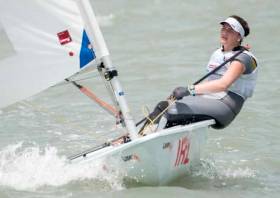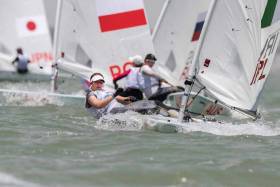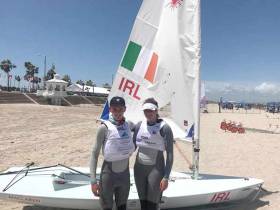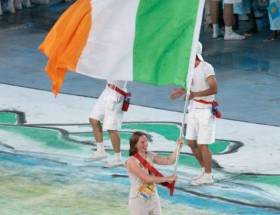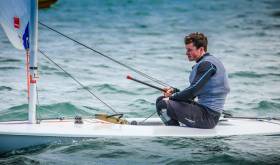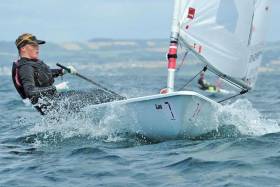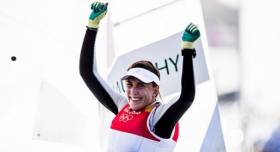Displaying items by tag: Laser Radial
Staunton Leading Irish At Laser Radial Youth Worlds In Kiel
#Laser - A 12-strong team is representing Ireland at the Laser Radial Youth Worlds in Kiel, Germany which kicked off over the weekend.
Best of the bunch thus far is Nell Staunton of the National Yacht Club, fresh off her eight-place finish in last month’s Youth Sailing Worlds in the US, who stands in 18th place in the girl’s division on 23 points after two races.
Clare Gorman, also of the NYC and the only other Irish girl in Kiel, is in 67th after a black flag in her first race.
Leading the Irish contingent in the boys’ division is Hugo Kennedy (Royal St George), who holds 32nd place on the leaderboard on 22 points after two races.
Geoff Power (Waterford Harbour; 47th) and Tom Higgins (RStGYC; 49th) are the closest Irish boys, with Toby Hudson-Fowler (RStGYC) in 81st despite an impressive eight-point score in his second race; Dan McGaughey (Donaghadee SC) 132nd; Peter Fagan (Skerries SC) 138th; Henry Higgins (RStGYC) 148th; Jack Fahy (Lough Derg YC) 178th and Paddy Cunnane (Dingle SC) trailing at 207th with a disqualification in his first race.
Those struggling down the table have four more qualifiers to go before the big fleet races later this week.
The National Yacht Club's Nell Staunton continues to race in the top ten of the Laser Radial Girls class of the 2018 Youth Sailing World Championships at Corpus Christi Yacht Club in Texas. The Dublin school girl had another solid performance yesterday, scoring eight and 11 in the two races sailed.
46 are competing in the girls class.
Overall, after four races Staunton drops one place from her eighth position after day one.
In the boys Laser Radial class, Jack Fahy of Lough Derg and the Royal St. George Yacht Club drops back slightly from 19th to 22 from 58.
Results are here.
Ireland is competing in two single-handed classes at the Youth Worlds in Texas, there is no Irish representation in any of the double-handed classes.
In winning all three races by comfortable margins, Argentina's Nacra 15 crew of Teresa Romairone and Dante Cittadini have forged a comfortable lead in the open multihull class at the 48th Youth Sailing World Championships.
Romairone and Cittadini have posted the low score of eight points, good for a 13-point lead over Germany's Silas Mühle and Romy Mackenbrock. The German duo is tied with Belgium's crew of Henri Demesmaeker and Frederique van Eupen but hold the tiebreak advantage with two first-place finishes to the Belgians' one.
The day, however, belonged to the Argentinians.
"I think we managed to have good speed and to be consistent," said Romairone. "We didn't have great starts but we were fast and played the gusts well."
Romairone sailed the Youth Worlds last year in the 29er Class and placed 18th. She switched to the Nacra 15 at the behest of Argentina's sailing federation in preparation for the Youth Olympic Games, which will be held in Buenos Aires in October.
"This is very exciting," said Romairone. "There are so many different people, it's very fun and good preparation for the Youth Olympics."
After two days of racing with anywhere from four to six races completed, the top three in many classes have started to separate from the pack after being tightly bunched yesterday. It's a testament to the good sailors figuring out the racecourse and how to keep their boat moving in the choppy waters and gusty winds.
Romairone and Cittadini weren't the only ones to put forth great efforts today. Norway's Mathias Berthet and Alexander Franks-Plenty moved into the lead in the Boys' 29er Class by posting a 2-1-1. They now have the low score of 11 points and lead Seb Lardies and Scott Mckenzie of New Zealand by five points with Australians Henry Larkings and Miles Davey another two points behind.
Berthet and Franks-Plenty also represented Norway at last year's Youth Worlds in the 29er, where they won the silver medal. They got off to a slow start this year with a 6-8 in the first two races, but in the four races since then have found a faster gear.
"Yesterday we weren't very satisfied with our speed. We weren't used to the choppy conditions," said Berthet, the 17-year-old skipper. "Today we had good starts and a really good feeling on the upwind legs. It was a very good day for us."
"We're really happy about today," said Franks-Plenty. "We were sailing it low and fast, Aussie style. It paid off to go right and we started banging the right on every upwind leg. I'm not sure if it was the wind or waves or current, but the right was good. Maybe the wind was a bit stronger."
In the Girls' 420 Class the reigning gold medalists, Carmen and Emma Cowles of the U.S. stubbed their toes in one race then bounced back to win the second by a large margin. Since they've completed more than three races they're permitted to discard their worst finish. That means that the Cowles are counting three first-place finishes and lead the class by 4 points over Vita Heathcote and Emilia Boyle of Great Britain. Spain's Julia Minana Delhom and Silvia Sebastia Borso di Carminati are third with 8 points.
"We just jumped the line a bit in the first race," said Carmen Cowles, the skipper. "If we keep cool and collected in the boat, it'll be fine. The event's still up for grabs, so we'll have to stay conservative on the start line. We can give up a half length to not worry about being over."
The Cowles twins won the class last year by 26 points, counting all firsts and seconds and discarding a disqualification. And although they now have recorded a discard, Emma Cowles, the crew, complemented her sister for keeping the boat moving fast.
"After the start we're focusing on keeping the bow down and going for the pressure," said Emma Cowles. "Carmen's doing well with the controls in the boat and making sure we have max power."
Elsewhere in the fleet, Geronimo Nores of the U.S. continued to lead the way in the Boys' RS:X Class. The tall, 6-foot, 6-inch sailor added a 1-2 to yesterday's three first-place finishes, while discarding a fourth, and has six points in five counted races. He leads Italy's Nicolo Renna by four points and France's Fabien Pianazza by seven points.
In the Girls' RS:X Class last year's bronze medalist, Girogia Speciale of Italy, has taken the lead after winning all three races today. Speciale leads New Zealander Veerle ten Have by one point and Islay Watson of Great Britain by two points. The top three have separated from the pack as fourth-placed Weronika Marciniak of Poland is 15 points behind Watson.
Laser Radial Girl Nell Staunton Eighth After Two Races at Youth Sailing Worlds in Texas
After two races sailed at the 2018 Youth Sailing World Championships at Corpus Christi Yacht Club in Texas, Ireland's Nell Staunton of the National Yacht Club lies in eighth position from 46 overall in the Laser Radial girls Class.
In the boys Laser Radial class, Jack Fahy of Lough Derg and the Royal St. George Yacht Club is 19th from 58.
Results are here.
More than 30 years have passed since the Youth Sailing World Championships have been held in the U.S.A, but if the week continues as it started for Team USA this regatta will long be remembered by the 14 American teenage sailors.
Following on from last evening's splendid Opening Ceremony hosted by 11th Hour Racing and The Harte Institute, a blustery southeasterly breeze allowed for the full complement of 23 races scheduled among the nine classes.
Team USA leads three classes-the Boys' RS:X and 420 and Girls' 420-and is placed second in another-the Girls' Laser Radial.
No one on the US team shone brighter today than Geronimo Nores, the 18-year-old representative in the Boys' RS:X Class. Nores won all three races and leads with the low score of 2 points. (Each crew in every class gets to discard its worst finish after three completed races.)
"I'm pretty surprised, it's very exciting," said Nores, whose first name is from his Argentinian mother and not a reference to the legendary American Indian. "It was a combination of good wind, being well rested and energized, and sailing well."
Energy has been lacking for Nores in the past year. It was one year ago when he was diagnosed with diabetes while racing in France. It turned out to be such a severe case that he has a canine working dog, a 20-month-old yellow Labrador named Luna, by his side at all times to alert him if his blood sugar levels drop to dangerously low levels. Luna even goes on the coach boat to monitor Nores in between races.
"I spent a week in the hospital in France," said Nores. "This year has been about recovering and getting back to sailing. I've had a difficult time competing, being on the water. It's amazing to see the progress I've made pay off on a day like today."
Although Nores put forth a commanding performance, the Boys' RS:X Class is tightly bunched. Second-placed Nicolo Renna of Italy has four points, third-placed Aleksander Przychodzen of Poland has seven points, fourth-placed Fabien Pianazza of France has eight points, while Leonidas Tsortanidis of Greece and Jim van Someren of the Netherlands each have nine points.
Every class is tightly packed after the first day, a result of just one day of racing but also of well-prepared sailors. In the Boys' 420 Class, JC Hermus and Walter Henry of the U.S.A. lead by five points, but second through 10th are separated by just seven points.
"It felt good today," said Hermus, the skipper who is on leave from the U.S. Naval Academy. "It was pretty fluky, there were some big shifts and some puffs came out of nowhere, so I'm happy for the consistent scores. We were just trying to stay out of the fray and survive the first day."
In the Boys' Laser Radial Class, Argentina's Juan Cardozo and Norway's Uffe Tomasgaard each have eight points, but Cardozo holds the tiebreaker by winning the second race. Australia's Zac Littlewood and New Zealand's Josh Armit are also tied with nine points, but Littlewood holds third place over his trans-Tasman Sea rival by winning the first race.
In the Girls' 29er Class, Norway's Pia Andersen and Nora Edland have three points, followed by Russia's Zoya Novikova and Diana Sabirova with four points, Germany's Maru Scheel and Freya Feilcke with six points, Italy's Michelle Waink and Claudia Gambarin with six points, and the USA's Berta Puig and Bella Casaretto with seven points.
The Girls' RS:X Class sees New Zealander Veerle ten Have in the lead with two points, followed by Islay Watson of Great Britain with three points and Italy's Giorgia Speciale with five points.
The Girls' Laser Radial Class is led by Emma Savelon with three points, followed by Charlotte Rose of the U.S.A and Poland's Wiktoria Golebiowska, tied on five points. Rose, the gold medalist in the class last year, won the second race to hold the tiebreaker over Golebiowska.
Another returning gold medal crew, Carmen and Emma Cowles in the Girls' 420 Class, picked up where they left off last year. The sisters won both races and lead the class with two points. Great Britain's Vita Heathcote and Emilia Boyle, Spain's Julia Minana Delhom and Silvia Sebastia Borso di Carminati and Switzerland's Solene Mariani and Maude Schmid all have six points apiece for second, third and fourth place, respectively.
In the Nacra 15 Class, Germany's Silas Muhle and Romy Mackenbrock lead with two points from their three completed races. Belgium's Henri Demesmaeker and Frederique van Eupen have three points, Argentina's Teresa Romairone and Dante Cittadini have five points, Laila Van der Meer have and Bjarne Bouwer of the Netherlands have eight points and Arnaud Grange and Marie van der Klink have nine points.
The Boys' 29er Class was the last one off the water this evening and Australians Henry Larkings and Miles Davey lead with the low score of three points in another tightly packed class. New Zealanders Seb Lardies and Scott Mckenzie hold second with four points, Italy's Federico Zampiccoli and Luca Fracassi are third with six points.
Racing is scheduled to resume today with another 23 races planned among the nine classes.
Ciara Peelo To Coach At Laser Training Weekend This Month
#Laser - Irish Laser Radial Olympian Ciara Peelo will be head coach for the Irish Laser Class Association’s upcoming training weekend on 24-25 March.
The Beijing 2008 flag-bearer will offer her guidance especially to lighter and female Laser sailors over the weekend, which is hopeful for a big turnout spurred on by the ‘Annalise Effect’.
Find out more about how to take part on the Irish Laser class website HERE.
NYC’s Loghlen Rickard Sails Strong In Laser North Americans
#LaserRadial - National Yacht Club sailor Loghlen Rickard was a close second in the Laser Radial at this past weekend’s Leinsters in Rush.
It’s the latest strong result for the youth sailor who recently took his talents some 7,000km west for the Laser North American Championships in Vancouver, Canada.
Racing was held over for days of varied light to medium winds at the Royal Vancouver Yacht Club on English Bay from 21 June.
Loghlen started strong with a bullet in race one, and had eight top-five finishes in the 12-race event.
The NYC sailor and Fort Lauderdale’s Sophia Reineke came off the water after 12 races tied on points in first and second respectively.
But a controversial protest saw them both disqualified from the last race, resulting in Vancouver’s own two-time Olympian Luke Ramsay taking the top step of the podium and Loghlen slipping to sixth after discards.
Nevertheless, it was a remarkable showing from the Dun Laoghaire stalwart, who also recently competed at the Radial Youth Euros in Poland.
East coast sailors emerged top of the three Laser divisions after a very tricky day at sea at the Rush Sailing Club hosted Leinster Championships writes our special correspondent.
Three races sailed bringing in a discard. Overall results, subject to protest, are downloadable below.
2020 Olympic campaigner Liam Glynn from Ballyholme Yacht Club, a former Topper World Champion, was the winner by four points of the 19–boat standard rig division when he overtook the host club's overinght leader Alan Ruigrok.
In the Radial division, Wexford Boat Club's Ronan Wallace was the winner. The 4.7 division was won by Tom Higgins of the Royal St. George Yacht Club.
Today's breeze was shifty with very strong rain squalls. There was a good 15–18 knots of mean wind with gusts past 23-25 knots. There was a 'nasty' sea state and a swell, not the same direction as the breeze. A wind blown chop on top of the swell made it 'like a washing machine', according to one competitor.
Rush race management was generally good but a little bit slow between races, according to some sailors. Organisation ashore was excellent, however.
#Laser - Aoife Hopkins took the lead at the U21 Laser Radial Women’s Euros in Douarnenez yesterday (Thursday 20 July).
As previously reported on Afloat.ie, the Olympic triallist from Howth Yacht Club had been just a single point off the lead after the first two races.
But two strong performances in yesterday’s two races and this morning’s single outing have put Hopkins on top, two points ahead of fellow Irish sailor Aisling Keller of Lough Derg YC.
Racing was postponed after race five due to strong winds with gusts of 35 knots. The event is set to resume with the start of the final series tomorrow (Saturday 22 July).
Elsewhere in Douarnenez, former Topper World Champion Liam Glynn from Ballyholme YC has climbed up the rankings of the boy’s Laser fleet to seventh overall after five races.
Olympic Silver Medallist Annalise Murphy Is Irish Sailor Of The Year 2016 (Updated with Photo Gallery)
#SailorOfTheYear – Olympic hero Annalise Murphy has been named Afloat Irish Sailor of the Year for 2016.
August’s Sailor of the Month for her silver medal victory at Rio 2016 was presented with her prize by Irish Sailing Association (ISA) president David Lovegrove at the Volvo Irish Sailing Awards gala in Dublin’s RDS Concert Hall this evening (Friday 27 January).
Murphy was saluted by more than 300 of her fellow sailors, one of Irish sailing’s largest ever turnouts, for her Olympic triumph in the Laser Radial class – Ireland’s best achievement in sailing at the Games since David Wilkins and James Wilkinson won the Flying Dutchman silver at Moscow 1980.
That the National Yacht Club stalwart rallied from her heartbreak at London 2012, where she just barely missed out on a bronze medal, with an incredible display on the waters of Guanabara Bay made her success all the sweeter.
As Afloat.ie’s WM Nixon wrote in November, Murphy’s Olympic performance came after a 10-week transformation on the heels of a poor showing at the 2016 Worlds in Mexico:
“With her dedicated support team, she ensured that she’d become a hugely improved sailor, a fitter athlete and psychologically in a very good place, as she took on the Olympic challenge on August 8th with a cool confidence which in due course received its proper reward.”
It was an achievement that rightly captured the public’s imagination, too, providing Irish sailing with the greatest mainstream profile it’s enjoyed in years.
It’s already seen her recognised as The Irish Times/Sports Council of Ireland Sportswoman of the Year, Irish Tatler’s Woman of the Year, the Evening Echo’s Sports Star of the Year, and as one of Rehab’s two Sportspersons of the Year, not to mention her honorary membership of the Irish Sailing Foundation.
So it was surely to be expected that ‘Our Annalise’ would capture the public vote on Afloat.ie, as well as the votes of the judging panel to earn the prestigious award for a second time upon its 20th anniversary – two decades after first honouring that year’s own Olympic dinghy hero Mark Little, and four years on from her first win in recognition for her stellar efforts in London.
Accepting her prize, Annalise Murphy said: “As a kid I learned that maybe I wasn't the most talented, but I worked the hardest and that’s how I handled my sailing at the Olympics, and that’s what I’d advise all sailors to do now.”
Adding that the standing ovation from the ISA “means a lot to me”, she noted that it was “great to see all the Irish sailing achievements here, and that’s what I love in our great sport. It’s not all about the racing.”
Racing is still very much on Annalise’s agenda, however, with the first stage of her Tokyo 2020 campaign set for the Laser Radial Worlds this August.
Annalise’s accolade must also be seen in light of her fellow deserving nominees, all winners of Afloat.ie’s Sailor of the Month awards, and all of whom made remarkable and significant contributions to Irish sailing throughout the year.
Among them are a GP14 world champion in Shane MacCarthy, a Round Ireland record by Damian Foxall, a pioneering Vendée Globe effort by Enda O’Coineen, and youth sailor and future Olympic medal prospect Finn Lynch.
Irish sailing’s next generation was recognised in its own right on the night with the presentation of the Youth Sailor of the Year prize to Afloat’s racing Sailor of the Month for July, Ewan McMahon, alongside the Training Centre of the Year gong that this year went to Foynes Yacht Club, and two ISA President’s Awards – to Scottish Series racer Colin Moore, and Annalise Murphy's coach Rory Fitzpatrick, the latter of whom said of his eventful year: “It’s not just the Olympic result, it’s the inspiration of Annalise’s discipline routine in Dun Laoghaire that drives on our Laser sailors.”
In his address earlier this evening, ISA president David Lovegrove said he was “bowled over by the achievements of our sailors both at home and abroad.
“For such a small country, we achieve great things and our sailors are truly inspirational ambassadors for our sports and our country. 2016 was a year to make us all proud.”
But Lovegrove also took time to “celebrate the everyday heroes in sailing who don’t always get recognised by awards and cups – the volunteers who dedicate so much time, energy and passion to our sport, and who share their knowledge and expertise with other sailors.
“From the race officials to the instructors, to the coaches and the mark layers, the safety crews and those who carry out a multitude of tasks onshore: we simply could not enjoy sailing the way we do without you. Thank you.”
Hosted by master of ceremonies Fiona Bolger, chief executive of Spinal Injuries Ireland, along with Lovegrove and Afloat.ie’s own WM Nixon, the evening welcomed guests including members of the ISA Olympic and youth sailing squads, training centre principal, national senior and youth champions, class captains and club commodores, and a number of past Olympians and Sailors of the Year.
Great night @Irish_Sailing #Volvosailingawards celebrating our win with Irish Sailor of the Year @Annalise_Murphy pic.twitter.com/ePsrX1QUTy
— Clontarf Y&BC (@TarfYBC) January 27, 2017
Among the crowd were the Royal Cork's Sally O’Leary and her husband Anthony, 2010's Sailor of the Year, who are looking forward to the club’s dinghy fest, along with a band of club mates including Gavin Deane, Admiral John Roche and Rear Admiral Kieran O'Connell and Tom Durcan, who has just welcomed home his son Johnny from Australia, and Ted Crosbie who recently retired from racing.
Brian O’Sullivan and Francis Clifford represented Tralee Bay Sailing Club in the audience this evening, while Paddy Boyd, who was returned from a stint as CEO of Sail Canada, was also present, as were Chris and Sandra Moore of the Dublin Bay Sailing Club, Peter Ryan of ISORA, ICRA Commodore Simon McGibney from Foynes Yacht Club, and Martin McCarthy of Annalise’s home club, the National YC in Dun Laoghaire.
Others in attendance included Cormac Devlin, Cathaoirleach of Dun Laoghaire-Rathdown County Council, and Sport Ireland chief executive John Treacy.
Laser Sharp Hemeryck Sailing In Top Ten at Youth Worlds
Both of Ireland's Laser Radial sailors are off to a strong start at the at the Youth Sailing World Championships after four races races sailed in New Zealand. The National Yacht Club's Nicole Hemeryck is in the top ten of the Girls Laser Radial fleet Royal Cork's Johnny Durcan is 12th in the Boys fleet. Full results are here.
Hemeryck counts three results in the top ten (6, 9, 7) to be eighth overall in her 48–boat fleet.
It's tight at the top of both Laser Radial fleets as the discard came into play, allowing a chosen few to start forming breakaways from the rest of the field.
Conditions were mixed on the Hauraki Gulf as a light 4-6 knot breeze dialled up later in the day to the mid-teens. The mixed breeze brought mixed results as light wind specialists excelled one minute and suffered the next, and vice versa for the sailors who thrive in strong breeze.
Laser Radial leader Patrick Doepping (DEN) had mixed fortunes. Doepping finished day one with two bullets but in Saturday's racing the Dane fell right to the back of the fleet finishing a lowly 37th, "I think the difference is I am a full rig sailor,” explained Doepping. "I am 80-82 kilos so for me in the light breeze it's very hard to keep the speed. In the strong breeze I don't have the disadvantage I have in the light breeze and that's why I didn't do well today.”
Doepping followed up with a seventh as the conditions fell in his favour enabling him to discard his 37th. Despite a self-proclaimed disappointing day, Doepping remains ahead of the fleet and isn't letting this affect his mentality, "I have been very calm and haven't been in any situations so far. I will keep doing what I've done over the last couple of days and avoid any mistakes.”
Only four points separate the top five and Doepping's discard could play a big role at the end of the week if he does get in to any situations. Doepping will have to keep watch as Great Britain's Daniel Whiteley is ready to pounce, looking to move up from fifth. Whiteley has been sailing near the top of the fleet in every race so far, but it's not good enough, or great enough for the Briton, "It was pretty challenging out there today. I got a sixth in the first race and a 13th in the last race so I'm not too happy, but it leaves me in contention.
"Tomorrow I can go out and do a bit better and climb the leaderboard. I haven't properly messed up yet. I'm consistent and hopefully I can make it consistently great rather than consistently good.”
Whiteley's discarded 13th is better than those around him and that gives him a little breathing space, "Maybe I have a little less pressure, but you can't think like that. We've got another three days, another five races and that's over half the championship so we will have to see how it shapes up.”
Sandwiched between Doepping on top and Whiteley in fifth is George Gautrey (NZL) in second, Dominik Perkovic (CRO) in third and Finnian Alexander (AUS) fourth.
It was Sandra Luli's day in the girl's Laser Radial and the Croatian remains on top. Talking through her day Luli said, "Today it was light winds. Compared to yesterday, tactics and speed was more important as the wind was always changing. In the first race I finished eighth and second race I finished first.”
Luli can discard her eighth place finish which gives her a nice six point cushion over Rio 2016 Olympian Dolores Moreira Fraschini (URU) who discards her 17th and counts her second.
Sitting in third is Germany's Anderssohn who summed up the day for just about every Laser Radial sailor in Auckland, "For me I think it wasn't such a good day. The first race was okay but the second wasn't very good. I think it changed a lot and everyone had a bad race. It was very shifty so you don't know where to go and there was less wind. It was hard conditions.”
Of the day one frontrunners defending champion and Rio 2016 sailor Maria Erdi (HUN) dropped down to fifth after a 15th and a UFD, which she discards.
Erdi came ashore after racing and was left confused about her performance, "There are some pretty good people here, but I just wasn't expecting myself to do this bad in shifty winds.” The Hungarian will have to sail smarter for the rest of the championship to stay in contention.
Annalise Is Sportswoman Of The Year
#Annalise - 2016 draws to a close with another accolade for Ireland’s Olympic hero Annalise Murphy, who was named The Irish Times/Sports Council of Ireland's Sportswoman of the Year in Dublin this afternoon.
The Laser Radial silver medallist was Sportswoman of the Month for August, the same month of that outstanding achievement for Irish sport in Rio de Janeiro.
And that’s not counting her Sailor of the Month nod from Afloat.ie in August, as well as Irish Tatler’s Woman of the Year gong last month, her honorary membership of the Irish Sailing Foundation, the Sports Star of the Year Honour at last night's Echo Sports Awards, and a share of Rehab’s Sportsperson of the Year Award.
The last one she couldn’t accept in person as she enjoyed a well-earned break, dabbling in her ‘hobby’ of Moth sailing at competition level in Bermuda.
That dedication to her craft — which included a 24-hour whirlwind round trip to bring home her medal-winning dinghy — is what we’ve come to expect from our Annalise over the years.
And this latest award shows how the rest of Ireland’s sporting world is catching on. Well done, Annalise!
More from David O'Brien in the Irish Times HERE



























